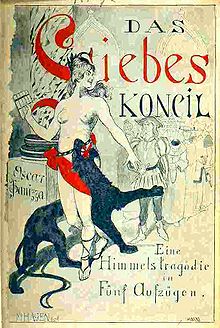Max Hagen

Max Hagen (born October 25, 1859 in Flensburg , † March 26, 1914 in Schliersee , Upper Bavaria ) was a German landscape painter , draftsman and caricaturist .
Life
Hagen was born as the second of five children to a merchant family and was supposed to start an apprenticeship as a locksmith after dropping out of secondary school , but he was physically unable to cope with it. In Silesia he then tried training as a businessman. A Hamburg painter recognized his talent there and advised him to attend an art academy . Hagen then became a student at the Academy of Fine Arts in Munich in 1883 .
In contrast to the prevailing art style that perfectly reproduces eventful subjects watched painted Hagen, who in Windach am Ammersee lived, impressionistic inspired oil paintings of unspectacular landscape am Ammersee as the great Impressionists in France or even like Ludwig von Gleichen-Russwurm in Bonn country .
In 1891 Hagen was able to exhibit for the first time in the Glaspalast in Munich , in the Munich Secession , and later also at the Great Berlin Art Exhibition . In 1892 he received the silver medal of the Munich Academy “Bene merito” for one of his landscapes . Nevertheless, Hagen was only able to sell a few pictures because his style did not meet the prevailing taste of the time. In addition, the competition in Munich was too great.
Mathilde Panizza, mother of the writer Oskar Panizza and owner of the hotel "Russischer Hof" in Bad Kissingen , could afford to live in Munich in winter. She booked painting lessons with Hagen for her granddaughter Mathilde Collard, daughter of the Bad Kissingen hotel owner Gustav Collard. Mathilde Collard was a docile student. The painting lessons eventually turned into love, and in 1913 Hagen married his student. For Oskar Panizza, Hagen drew the title page for his play The Love Council (1894).
Hagen's patron Mathilde Panizza also bought some paintings from him, some of which are still privately owned in Bad Kissingen today. Hagen could live with the sale of pictures and with his painting lessons. In 1896 he drew caricatures for the new weekly magazine Jugend and in 1897 became its permanent employee. He became even better known when, from 1900, the satirical magazine Simplicissimus regularly published his humorous caricatures.
Hagen died on March 26, 1914 during a ski trip near the Schliersee , where he is also buried.
literature
- Gerhard Wulz, The Long Forgotten Late Impressionist , in Saale-Zeitung March 17, 2001.
- Dieter Pust: Theodor Sander and Max Hagen. Two local artists and the promotion of their training by the city of Flensburg . In: Nordelbingen, vol. 77, 2008, pp. 125-138.
Web links
| personal data | |
|---|---|
| SURNAME | Hagen, Max |
| BRIEF DESCRIPTION | German landscape painter, draftsman and caricaturist |
| DATE OF BIRTH | October 25, 1859 |
| PLACE OF BIRTH | Flensburg |
| DATE OF DEATH | March 26, 1914 |
| Place of death | Schliersee , Upper Bavaria |
